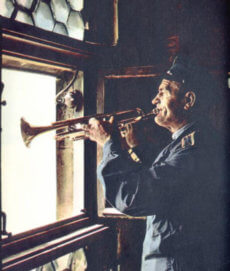Another Young Man with a Horn

Every hour, day and night, year in and year out, from the higher of the two towers of the Basilica of St. Mary, a trumpet call sounds over the ancient Polish city of Krakow. The call is repeated four times, from the north, south, east and west windows of the tower. Each time the melody, a medieval Polish hymn, is played, it stops before its finish, as if cut off.
The trumpet call is the signal of the city watch of Krakow. The interruption of the melody commemorates a trumpeter in 1241, who refused to abandon his post during the siege of Krakow by the Mongols. As he played, he took an arrow through the throat.
It is a story very important to Poles. The trumpet at noon is broadcast over the national radio.
In 1928, American author Eric P. Kelly wrote an historical novel for young people, The Trumpeter of Krakow, which bears on this tradition.
The Trumpeter of Krakow was a great success in both the United States and in Poland itself. There was a triumphant book tour, and Mr. Kelly received the Newbery Medal for children`s literature in 1929. It remains an established classic.
This status is by no means unmerited. Even your essayist, who is a skeptic about historical novels and young people, was pleasantly surprised. The action is rapid and twisty. The characters are distinct and rounded. The mise-en-scene, the medieval city of Krakow, is detailed and vivid and has all the marks of really thorough and sympathetic research.
The novel’s hero, Joseph Charnetski, son of a Polish landowner driven from his estate in the Ukraine, arrives in Krakow with his parents in 1461. They are pursued by enemies, for the father has with him a treasure, the Crystal of Tarnov, an object fraught with occult and political significance. The father takes a post as the night trumpeter from the church, and his son becomes his backup. In the course of the story, they meet with an alchemist, his evil German associate, and one Jan Kanty, a Polish national hero and saint (St. John Cantius). At the climax of the story about a quarter of Krakow is burned to the ground, as actually happened in 1462, but things end happily, more or less. There is a short epilogue set in the modern Krakow of 1926.
Most importantly, the novel has a moral centre, that “pith of philosophy” that Stevenson said is essential to a good story. The Crystal of Tarnov, around which the action revolves, is said to grant knowledge to those who stare into its centre. But it is a lie. The visions that appear originate in the inner mind of those who use the crystal, and what they see is an illusion.
We can, therefore, fully affirm the merits of The Trumpeter of Krakow. You`ll like it.
Nevertheless, seen from 2010, as we look back over the twentieth century, a century that merits the description of a cross between a Ferris Wheel and a werewolf (originally applied by a Chicago Newspaper man), the year when the book was written, 1928, becomes more and more significant.
Poland, like Brigadoon, keeps reappearing. It went under as a nation in 1795, divided between Germany, Russia and Austria, and did not return to existence until 1919. The politics involved are outlined in Paris 1919, by (Canadian!) author Margaret MacMillan and the process was not pretty. Still, there was Poland again and for the time things looked hopeful.
That hope shines through the book. Poland has a glorious past. Poland has a glorious future. Poland has control over the Ukraine and jolly right too. That that control is being contested is the sole fault of the ultimate villain of the story, Ivan the Terrible (for whom we may read a certain Russian with a big walrus mustache).
The author is 100% on the side of the Poles. Yet he can’t have been unaware that the Poles were divided among themselves, that they had seriously irritated the Allied powers, and that Poland was currently a dictatorship. Perhaps he felt these were temporary bugs in the software, and nothing to worry about. Nothing to vitiate the Polish national myth.
From 2010, we see that doom was closing in. And we may guess that we too at that time had a myth, a myth about Poland. Poland would be our representative, our enclave in Eastern Europe. Poland was not German, the all too recent enemy, nor Russian (Godless Bolsheviks!) and, although Slavic, seemed reasonably literate and not inclined to wearing funny ethnic costumes. They played pianos! They used Latin, not Greek, in their religion. For all these reasons, for a while, Poland was the Golden Boy among nations.
But it was an image out of our own subconscious, and bound to disappoint, when the Poles acted more or less the same as any other nation in history.
I and the public know
What all schoolchildren learn
Those to whom evil is done
Do evil in return.
Well Mr. Auden, you nailed that one. Historically speaking, we all have dirty hands, and we all have a bill coming. What answer can there be beyond saying , “Stop doing evil. Just . . . Stop.”




